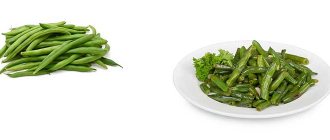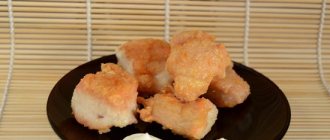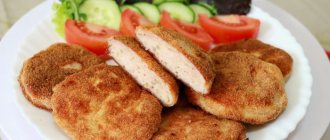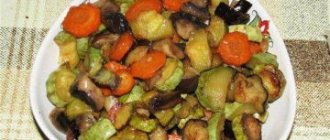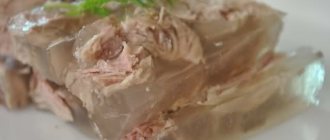It's hard to find a person who doesn't love the oriental dish called cabbage rolls. Appetizing cabbage envelopes stuffed with meat are surprisingly similar to their close “relatives” - dolma and sarma, wrapped in grape leaves. However, the high calorie content of pork and beef cabbage rolls stewed in tomato-sour cream sauce does not allow people who are watching their figure or losing weight to enjoy this popular dish.
How not to deny yourself the pleasure of tasting delicious cabbage rolls at least sometimes and not harm your waistline?
The benefits of cabbage rolls
All the ingredients from which cabbage rolls are prepared are beneficial for our body: vegetable fiber stimulates intestinal function and normalizes cholesterol levels; vitamin C, which cabbage is rich in, folic acid and potassium salts, are important components of the diet; amino acids, proteins and carbohydrates are building materials for cells, the source of which is meat, and when ground it is easily absorbed; rice is a mega-supplier of B vitamins, which are necessary for the normal functioning of the nervous system; they also help restore the healthy appearance of nails and hair.
Micro- and macroelements in vegetable cabbage rolls
Vegetable cabbage rolls contain the following elements: Mono- and disaccharides, Cholesterol, Ash, Starch, Water, Organic acids, Dietary fiber, Unsaturated fatty acids, Sodium, Potassium, Phosphorus, Magnesium, Calcium, Sulfur, Copper, Boron, Silicon, Aluminum, Titanium , Iodine, Manganese, Chromium, Fluorine, Molybdenum, Vanadium, Cobalt, Nickel, Rubidium, Selenium, Tin, Zinc, Iron, Chlorine.
| Micro and macro element | Meaning |
| Mono- and disaccharides, g. | 3,2 |
| Cholesterol, mg | 19 |
| Zola, Mr. | 0,8 |
| Starch, Mr. | 2,9 |
| Water, city | 89,1 |
| Organic acids, g. | 0,1 |
| Dietary fiber, g. | 2,3 |
| Unsaturated fatty acids, g | 0,2 |
| Sodium, mg | 27,4 |
| Potassium, mg | 233,5 |
| Phosphorus, mg | 69,7 |
| Magnesium, mg | 16 |
| Calcium, mg | 58,6 |
| Sulfur, mg | 39 |
| Copper, µg | 53,8 |
| Boron, µg | 99,9 |
| Silicon, mg | 1,9 |
| Aluminum, µg | 272,9 |
| Titanium, µg | 0,2 |
| Iodine, mcg | 4,6 |
| Manganese, mg | 0,1694 |
| Chromium, µg | 3,4 |
| Fluorine, mcg | 27 |
| Molybdenum, mcg | 5,6 |
| Vanadium, mcg | 1,7 |
| Cobalt, µg | 3,4 |
| Nickel, µg | 5,7 |
| Rubidium, mcg | 71 |
| Selenium, mcg | 0,2 |
| Tin, µg | 0,1 |
| Zinc, mg | 0,4785 |
| Iron, mg | 0,8 |
| Chlorine, mg | 47,1 |
What determines the nutritional value of cabbage rolls? Their types
It is no secret that the calorie content of cabbage rolls with minced pork and beef is noticeably higher than their “brothers” prepared with ground poultry, mushrooms or assorted vegetables inside. Therefore, nutritionists always recommend calculating not only the energy value of the products included in the recipe for your favorite dish, but also the calorie content of the sauce in which delicious cabbage “rolls” are stewed. It is necessary to take into account even the method of preparing the dish.
Stuffed cabbage rolls with minced chicken breast, stewed in a slow cooker or cooked in the oven, will be more dietary than high-calorie pork “rolls” from a frying pan. Mushroom “relatives” are not far behind them: the calorie content of cabbage rolls with porcini mushrooms without a rich sauce is approximately 55-80 kcal, and with cheese, sour cream and eggs – 160 kcal.
With pork
The most high-calorie option is made from pork. You can reduce calorie content by partially replacing the pork product with beef. Stuffed cabbage rolls with minced pork and beef can be prepared as follows:
- white cabbage - 1100 g;
- minced pork and beef - 700 g;
- rice - 200 g;
- onion - 250 g;
- carrots - 210 g;
- bell pepper - 150 g;
- tomato puree - 300 g;
- sour cream 15% - 2 tbsp. l.;
- butter - 1 tbsp. l.;
- dried paprika - 1 tsp;
- salt - to taste;
- ground black pepper - to taste;
- water - 320 ml;
- vegetable oil - 2 tbsp. l.
Preparation:
- Disassemble the head of cabbage into leaves. To do this, cut each one in the middle of the thick vein and remove it from the head of cabbage. Cut out the thick vein.
- Place the leaves in boiling salted water for 8-10 minutes.
- Rinse the rice, add cold water, bring to a boil and remove from the stove.
- Cut one onion into small cubes and add to the minced meat.
- Chop the remaining onion and grate the carrots.
- Fry carrots and onions, add chopped bell peppers and cook further.
- Put rice into the minced meat (it should be 2 times less than meat), salt, paprika, 70 ml of water.
- Place half of the cabbage leaves in the bottom of the pan. Place about a quarter of the fried vegetables.
- Lightly beat the leaves from which the cabbage rolls will be made with a hammer.
- Place minced meat on cabbage leaves and roll up.
- Place tightly in a pan in one layer, and place another portion of the vegetables on top. Place cabbage rolls and vegetables in the same manner until they are finished.
- Mix tomato puree with sour cream and water, add salt.
- Pour over the cabbage rolls and place the remaining leaves on top.
- Simmer for about an hour over low heat, covered.
The dish according to this recipe contains 118 kcal per 100 grams, including vegetable sauce. The BJU ratio will be:
- proteins - 4 g;
- fat - 9 g;
- carbohydrates - 5 g.
The calorie content of a meal with minced pork depends greatly on the fat content of the meat. On average, 100 g contains about 213 kilocalories. The amount of BJU for them will be: 8.6 g/16.1 g/11.4 g.
How many calories are in meat cabbage rolls?
In traditional recipes, the calorie content of cabbage rolls with minced meat and rice can be 110-120 kcal, or can reach 295-313 or more kilocalories. For 1 kg of pork and beef, usually take 1.5-2 cups of raw rice and one head of cabbage weighing approximately 1.5-2 kg. The sauce, which contains the following ingredients, also adds nutritional value to the cabbage rolls: 500 g of sour cream, 75-100 g of tomato paste and spices. The only component without calories is water - 500 ml. The calorie content of the sauce significantly increases the overall energy value of the dish, but it is difficult to accurately calculate how much of it will penetrate into each cabbage roll.
Therefore, they take the total calorie content of cabbage rolls with meat and rice, sum it up with the energy value of the sauce ingredients and divide the result by the number of finished envelopes. Classic cabbage rolls without sauce can contain 100-110 kcal per 100 g of semi-finished product, and with sauce - 220-300 kcal. If you add more beef to cabbage rolls and reduce the pork content, the proportion of protein in them will increase, and the energy value will decrease. The calorie content of meat cabbage rolls will also noticeably decrease if you prepare them from chicken breast. Experienced housewives can boil the envelopes, drain the primary broth and add boiling water to the dish being prepared. This significantly reduces the energy value of cabbage rolls and makes them more dietary.
With beef
For cabbage rolls with beef you need:
- minced beef - 500 g;
- onion (for minced meat) - 1 pc.;
- cabbage - 400 g;
- boiled rice - 100 g;
- salt (to taste) - 2 g;
- water (for stewing) - 200 ml;
- carrots - 1 pc.;
- onion - 1 pc.;
- greens (to taste) - 2 g;
- sour cream - 20 g;
- tomato paste - 20 g;
- sour cream (for serving) - 20 g;
- boiling water for cabbage.
Preparation:
- The minced meat is mixed with finely chopped onion and boiled rice, and salted.
- Cabbage leaves are poured over with boiling water to soften them.
- The minced meat and rice are placed on leaves and wrapped.
- Stuffed cabbage rolls with meat are dipped into boiling water.
- At this time, grate the carrots, finely chop the onions and mix them with 20 g of sour cream and tomato paste.
- Place vegetables in a pan with cabbage rolls.
- After this, simmer for another half hour over low heat.
The dish is served with sour cream. It is prepared in the same way with any other meat.
If you use beef, the energy value of cabbage rolls will be from 140 to 230 kilocalories per 100 g. The BJU ratio in this case will be:
- proteins - 9.4 g;
- fats - 6 g;
- carbohydrates - 13.1 g.
How not to exceed the calorie content of a meal with cabbage rolls?
In order to maintain a slim waist or stay within the daily caloric intake range for weight loss, you need to use several secrets when preparing cabbage rolls. As already noted, the calorie content of cabbage rolls with meat becomes less if you use secondary broth. Minced chicken breast instead of pork and beef will help reduce the energy intensity of the dish by 40-50%.
Classic lazy cabbage rolls contain 145-155 kcal per 100 g of delicious assortment. But the version of beef lazy cabbage rolls can “cost” the body only 120 kcal. If you eat small portions of 250-300g three times a day, and for snacks - eat an apple or drink unsweetened green tea with something dietary, then the daily calorie intake will fit within the range of 1200-1500 kcal. In this case, you won’t have to go hungry at all. If you eat pork lazy cabbage rolls, the calorie content of which will immediately increase by 50 kcal, then it can amount to 180-200 kcal per 100 g of your favorite dish. In this case, you will have to reduce the portion size and the number of meals consisting of cabbage rolls, replacing them with lighter options.
Calorie content of cabbage rolls with minced chicken, pork or beef
The fattest component of the dish is minced meat: as a rule, it accounts for up to 66% of calories.
Minced chicken, pork and beef are often used, which affects not only the taste, but also the BJU indicator and the energy value of the dish:
- chicken - contains less fat and more protein, the calorie content of 1 cabbage roll with chicken is 140 kcal;
- pork - has a high carbohydrate content, so there will be more calories in such cabbage rolls; on average, 100 g contains 300 kcal;
- beef - used for preparing lean dishes, as it allows you to reduce the calorie content of the dish to 170 kcal.
Be sure to read: How many calories are in 100 grams of cauliflower, beneficial properties and contraindications of the product
You can reduce the calorie content of cabbage rolls by not only choosing low-fat meat for the filling, but also by refusing butter, sour cream and sauces.
Lazy cabbage rolls: calorie content
Lazy cabbage rolls are considered a separate type of everyone’s favorite dish. Housewives like the convenience of preparing them, when they do not have to wrap each envelope, but simply mix delicious ingredients and bring them to readiness in a slow cooker or oven, in a regular frying pan or even in a saucepan (with a thick bottom). Mothers with babies like lazy cabbage rolls because they don’t have to spend a long time in the kitchen. Having quickly mixed the prepared ingredients, you can then pay attention to your child while the future dish is stewed in the oven.
At the same time, the energy value of such a dish can be adjusted by selecting dietary products. The calorie content of lazy cabbage rolls with chicken breast and without sour cream from a multicooker is 145-154 kcal per 100 g of dish, from the oven - 117 kcal. In a frying pan, cabbage lasagna can be obtained with an energy value of 170 kcal per 100 g of delicious assortment. The cabbage in lazy cabbage rolls can be finely chopped and blanched (scalded with boiling water) or you can surprise your household with an improvisation...
Cooking recipes and energy value
There are various recipes for preparing the dish; the calorie content will depend on the method of preparation.
The classic recipe for Slavic cabbage rolls is simple and optimal in energy value
Despite the different recipes, the main ingredients remain the same: cabbage, minced meat, spices, rice or other porridge.
Popular recipes include:
- classic (150 kcal),
- dietary (119-130 kcal)
- with mushrooms (49 kcal),
- vegetable (43 kcal),
- pickled (59 kcal);
- lasagna (90 kcal).
In addition, all kinds of vegetarian recipes are also very popular, allowing you to reduce the usual calorie content several times.
Classic recipe
Classic recipe for Slavic cabbage rolls
The classic recipe for Slavic cabbage rolls is simple and optimal in energy value.
It includes the following products:
- white cabbage – 800 g;
- carrot;
- bulb;
- minced meat - half a kilo;
- rice porridge - half a glass;
- parsley – 10 g;
- pasta – 2 tbsp. l.;
- garlic – 2 cloves.
Cooking the dish includes the following steps:
- Wash the head of cabbage and divide it into individual leaves, boil them in boiling water until they become soft.
- Chop the onion and carrot, fry until golden brown.
- Boil the rice porridge until half cooked.
- Mash the meat, add chopped herbs and garlic, salt and pepper.
- Add porridge, frying.
- Wrap a little filling in each cabbage leaf and lightly fry.
- Place in a saucepan and add half a glass of pasta water.
- Cook for 30 minutes.
The dish is served with low-fat sour cream and can also be sprinkled with hot spices.
Diet option
The calorie content of cabbage rolls with vegetables and chicken is the lowest, so they are considered dietary.
Be sure to read: What are the benefits of Chinese cabbage: BZHU, calorie content, recipes for weight loss
For cooking you will need the following ingredients:
- brown rice porridge - half a glass;
- cabbage – 800 g;
- minced chicken – 50 g;
- bulb;
- carrot;
- tomato – 4 pcs.;
- egg – 1 pc.
How to prepare the dish:
- Chop carrots, onions, add tomatoes.
- Beat the egg into the minced meat.
- Boil rice porridge, add vegetables to it.
- Scald the head of cabbage with boiled water and remove the leaves.
- Wrap the minced meat in leaves and place on the bottom of the pan.
- Pour in tomato paste, diluted with water, salt and pepper.
- Cook over low heat for about an hour.
Cabbage lasagna
Cabbage lasagna
Cabbage lasagna is a new version of cabbage rolls, the calorie content of which is noticeably lower than the traditional dish.
Ingredients:
- white cabbage – 1 kg;
- onion – 1 head;
- celery leaves – 30 g;
- Chicken fillet – 550 g;
- lasagna – 6 sheets;
- milk – half a glass;
- white flour – 2 tbsp. l.;
- low-fat cheese – 150 g.
Preparation:
- Chop a head of cabbage.
- Chop the onion, celery, fry everything in a frying pan until golden brown.
- Cut the fillet into cubes and add to the pan, simmer for 5 minutes.
- Whisk the milk and flour in a separate bowl and make the sauce.
- Cover the baking dish with lasagna sheets, alternating with the filling.
- Pour milk sauce on top, sprinkle with grated cheese and bake for half an hour.
Mushroom cabbage rolls
Mushroom cabbage rolls
Mushroom cabbage rolls have a huge advantage over other recipes - they have significantly fewer calories, so this dish can also be considered dietary. Preparing the dish takes no more than 30 minutes.
You will need:
- head of cabbage – 800 g;
- champignons – 400 g;
- rice – 200 g;
- onions – 2 pcs.;
- carrot – 1 pc.;
- sunflower oil - for frying;
- tomato juice - half a glass.
Preparation:
- Fry mushrooms with onions.
- Boil the rice porridge and mix with the fried mushrooms.
- Pour boiling water over the cabbage head, divide it into leaves, and wrap a portion of the filling in each leaf.
- Place the cabbage rolls in a saucepan, pour over tomato juice and simmer for half an hour over low heat.
- You can reduce the calorie content if you do not add sour cream at the end of cooking.
Vegetable cabbage rolls
These are cabbage rolls prepared according to a vegetarian recipe, without meat. They contain twice as many nutrients, vitamins and fewer carbohydrates. This version of the dish is suitable for dietary nutrition and fasting.
Be sure to read: Cauliflower diet dishes for weight loss: healthy recipes
The following products will be required:
- cabbage head – 1 pc.;
- white rice - a glass;
- carrots – 2 pcs.;
- onion – 1 pc.;
- tomato paste – 3 tbsp. l.;
- fresh parsley – 15 g.
Prepare a low-fat vegetarian dish according to the following recipe:
- Prepare a head of cabbage, wash, separate and pour boiling water over the leaves.
- Grind carrots, onions, garlic in a blender, add spices and finely chopped herbs.
- Boil rice porridge, add vegetables.
- Roll cabbage rolls into cabbage leaves.
- Place in a baking dish, pour over tomato juice and water, cover with foil.
- Bake in the oven at +180 degrees for about 25-30 minutes.
- Before serving, sprinkle with herbs and spices.
Marinated cabbage rolls
Marinated cabbage rolls
Marinated cabbage rolls with low fat content are suitable for those losing weight and those who are tired of the usual options.
To prepare such a dish, you will need to separately prepare a marinade from the following ingredients:
- water – 1.5 l.;
- vinegar - 4 tbsp. l;
- garlic – 3 cloves;
- sugar powder - 3 tbsp. l;
- salt – 2 tbsp. l;
- vegetable oil and spices.
The main ingredients are regular cabbage and Korean carrots, which can be purchased separately or prepared at home.
Preparation:
- Finely chop the cabbage and carrots, season with salt and pepper.
- Add sugar, vinegar, chopped garlic.
- Leave to soak for half an hour.
- Scald the cabbage and separate the leaves.
- Wrap carrots in leaves.
- Place the cabbage rolls in a bowl.
- Prepare a marinade from salt, sugar, water, vinegar and vegetable oil.
- Add spices and pepper.
- Heat the marinade and pour into a bowl with cabbage rolls.
- Leave for 1 day until completely saturated with marinade.
Cabbage lasagna
You can prepare your favorite dish in the form of cabbage lasagna: vegetable leaves, after softening them in boiling water, are arranged in layers. Leaves are placed on the bottom of a saucepan, multicooker or frying pan, then a layer of fried minced meat mixed with vegetables and half-boiled rice is placed. The top of the dish is covered with the remaining cabbage leaves. Next, it is covered with the remaining fried onions, bell peppers, chopped tomatoes and carrots. For those who count calories, you can fill lazy cabbage rolls with tomato paste diluted with boiling water and spices. You need to serve the dish, grabbing all the layers like cabbage lasagna.
Calorie calculation for 100 grams
As an example, we will calculate a portion equal to 100 grams - this is one of the standard weight measures that determines the total calorie content of a product or recipe.
The easiest and most universal option (suitable for calculating any volume of a product or ready-made dish) is calculation by multiplying the resulting calorie content (2080 grams) by a factor of 0.05, which is the result of division (100 g / 2080 g).
Calorie content of 100 grams of serving = 2196 * 0.05 = 110 kcal.
In addition, in the same way you can calculate the content of BZHU in the composition of a portion:
- Protein = 123.09 * 0.05 = 6.1545 ≈ 6.2 g.
- Fat = 115.03 * 0.05 = 5.7515 ≈ 5.8 g.
- Carbohydrates = 167.09 * 0.05 = 8.3545 ≈ 8.4 g.
6.2 * 4 + 5.8 * 9 + 33.6 * 4 ≈ 111 kcal
Our calculated calorie content is more than 50, but less than 250 kcal, which means that cabbage rolls are a medium-calorie dish with an average content of proteins, fats and carbohydrates.
Mushroom cabbage rolls
Diet cabbage rolls with mushrooms, unlike the classic recipe with meat, do not pose a threat to your waistline. Despite the various fillings: with rice, potatoes or eggs, mushroom cabbage rolls allow people on a low-calorie diet not to exceed the daily nutritional allowance. For example, cabbage rolls with mushrooms (champignons, honey mushrooms and others), vegetables and rice contain (without sour cream) 55-60 kcal, with sour cream - up to 85 kcal.
Their counterparts with potatoes and mushrooms can provide the body with up to 90-120 kcal per 100 g of dish. Lazy cabbage rolls with mushrooms, loved by many, contain from 120 to 140 kcal. The energy value of a lean mushroom dish can vary depending on the calorie content of the ingredients, the amount of food and the nutritional value of the sauce. A simple recipe for lazy cabbage rolls with mushrooms from products includes: 500 g of cabbage (you can take Chinese cabbage), 1 kilogram of any mushrooms, 200 g each of rice, carrots and onions, a little vegetable oil for frying and spices to taste. Heat the oil in a saucepan or cauldron, fry the onion, cut into half rings. Boil the diced mushrooms for 2-3 minutes, then drain in a colander to drain. Next, fry the mushrooms (10 minutes) along with onions, shredded cabbage, and carrots. Then salt the mushrooms and vegetables and pour boiling water over them until completely covered. Lazy mushroom cabbage rolls are stewed for about 10 minutes. Half-boiled rice is laid out in a layer on top and boiling water is added so that it covers the grains by 2-3 cm. Next, you need to increase the heat and cook the dish until the rice completely absorbs the liquid. Then reduce the cooking temperature, pierce the mixture to the bottom in several places, close the lid and simmer for another 15-20 minutes. Before serving, stir the lazy cabbage rolls with mushrooms. Giving them the appearance of a delicious dietary platter, the dish is sprinkled with herbs.
BZHU table
Average value of BZHU and calories in cabbage rolls of various types with different types of fillings:
| View | Squirrels | Fats | Carbohydrates | Calories |
| Chicken with rice | 7,6 | 7 | 8,9 | 119 |
| Pork | 6,1 | 23 | 20 | 311 |
| Beef | 11 | 16 | 7,1 | 155 |
| Lazy with chicken | 7,9 | 5,9 | 9,1 | 165 |
| With turkey | 6,5 | 6 | 9 | 115 |
| From pork and beef | 6,8 | 7,4 | 9,2 | 157 |
| From Chinese cabbage | 5,8 | 7 | 8,2 | 110 |
Vegetable cabbage rolls
A vegetarian dish - cabbage rolls with vegetable filling - is the most acceptable delicacy option for those who want to enjoy their favorite food, but not gain excess weight.
The calorie content of cabbage envelopes with vegetables is the lowest of all types of cabbage rolls. It is 55-65 kcal. Sauce without sour cream can add 23-28 kcal to these values.
Vitamins in Vegetable cabbage rolls
Vegetable cabbage rolls contain the following vitamins: Mono- and disaccharides, Cholesterol, Ash, Starch, Water, Organic acids, Dietary fiber, Unsaturated fatty acids, Sodium, Potassium, Phosphorus, Magnesium, Calcium, Sulfur, Copper, Boron, Silicon, Aluminum, Titanium , Iodine, Manganese, Chromium, Fluorine, Molybdenum, Vanadium, Cobalt, Nickel, Rubidium, Selenium, Tin, Zinc, Iron, Chlorine.
| Vitamin | Meaning |
| Vitamin B1 (thiamine), mg | 0,04 |
| Vitamin B2 (riboflavin), mg | 0,1 |
| Vitamin B6 (pyridoxine), mg | 0,1 |
| Vitamin B9 (folic), mcg | 17,4 |
| Vitamin C, mg | 18,7 |
| Vitamin E (TE), mg | 1,7 |
| Vitamin PP (Niacin equivalent), mg | 1,9644 |
| Vitamin B12 (cobalamins), mcg | 0,1 |
| Vitamin D, mcg | 0,1 |
| Vitamin A, mg | 0,2 |
| Choline, mg | 53,5 |
| Vitamin A (VE), mcg | 200 |
| Vitamin B5 (pantothenic), mg | 0,7 |
| Vitamin PP, mg | 1,4 |
| Vitamin H (biotin), mcg | 2,2 |
Indications for following diet No. 5
Diet No. 5 is a widely used therapeutic diet, and its main goal is to normalize the functioning of the liver and pancreas.
The diet for this diet is designed in such a way as to facilitate the functioning of organs that are at risk. That is, indications for following the “5th table diet” are, first of all, for people with chronic diseases who are in dire need of normalizing digestion. The diet is carried out together with treatment prescribed by a doctor to get rid of pain and alleviate discomfort. Diet 5 does not have clear time limits; the duration depends on the patient’s condition and is determined individually in each case. For chronic diseases, doctors recommend using it for a fairly long time, for example, about one and a half to two years. In case of chronic hepatitis, diet number 5 should be followed throughout life.
A diet for liver disease is not some newfangled diet that starves the human body, it is a balanced and proper diet. This nutritional method can be used not only as a therapeutic method, but also as a preventive one, which in any case will be useful and, perhaps, even necessary for the body. According to the diet, the amount of fats, proteins and carbohydrates must correspond to the physiological daily norm and any “excess” in one direction is not acceptable. At the same time, the intake of fatty foods is kept to a minimum, since fatty foods are a serious burden for the liver.
History and variations of cabbage rolls
From a historical point of view, cabbage rolls are a very diverse dish that has many variations in preparation. This is also due to the fact that it has a lot of historical roots. It is generally accepted that stuffed cabbage leaves are a distinctive feature of Eastern European cuisine. Unusual recipes for cabbage rolls are found in Bulgaria, the Czech Republic, Greece, Armenia, Kazakhstan, and Turkey. You're sure to find similar food options in East Asia. But the most popular among the Russian-speaking population were recipes for cabbage rolls from Ukraine and Russia.
In classic preparation, cabbage rolls are presented to a person as a cabbage leaf in which minced meat and rice are cooked. The meat chosen was mainly beef or pork. In Ukraine, a recipe using cracklings was widely used; cabbage leaves were taken, not fresh, but pickled. There were also potato cabbage rolls often here, or stuffed with finely chopped vegetables. This suggests that cabbage rolls are a universal demi-season dish. In modern diets, instead of beef and pork, you can use chicken, turkey or even fish in the recipe!
And, of course, you cannot ignore the two main options for preparing this nutritious dish:
- classic cabbage rolls, when the filling is wrapped in a cabbage leaf;
- lazy, when all the ingredients are mixed in one patch and stewed together.
